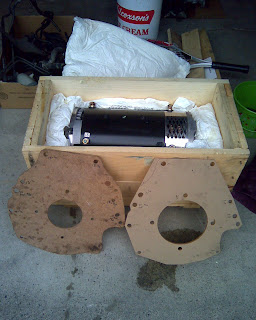Since the coupler and single plate setup is so simple the installation was really easy. I had to cut 1/4" off the motor shaft with a hack saw and I used a grinder to cut 1" off the drive shaft. Tony warned me about going really slow so the shaft didn't heat up and damage the bearings. It took about 2 hours. But, I got a lot of work done on the motor mount waiting for the shaft to cool.
Zach and I slide the motor under the frame with the front end on jack stands. We used a cable hoist suspended from the garage rafters to lift the motor into place once the coupler and plate were mounted. Because the transmission only has 2 mounts we put the jack under the adapter plate to level the motor for a test spin. I expected that wiring the motor for CCW would be correct... but I was wrong. The wheels spun backwards in first gear. The FB1-4001A can be wired for either direction so the jumper can just be switched.












